Howder Family Genealogy
Howder Homestead, Cambria Township, Niagara County, New York
Contents:
The Old Howder Homestead (public version(1))
N43°11.019'; W78°46.428'
Lower Mountain Road
Cambria Township, Niagara County, New York, United States of America
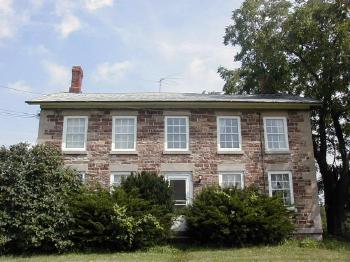 |
|
The Howder Homestead. Front (south) side of original home with main entrance |
Lover Mountain Rd., Cambria, NY |
George Howder arrived in the Niagara region from Pennsylvania as a child and a settler as early as 1811 with his parents Christian and Mary (Houstater) Howder(2). The "Old Howder Homestead" along Lower Mountain Road traces its origin to 1837 when George acquired 144.5 acres from Percy Hathaway(3) and subsequently built a "rough old stone house"(4). This was less than forty years after the Holland Land Purchase opened the territory formally to settlers of European descent(5).
The exact construction date is unknown. One source acknowledged that "the period between 1830 and 1840 was when that type of house was the prevailing style for farmers of moderate means"(6). A plaque on the front door of the house references the year 1839. This aligns with the available historical record.
The People.
In the early years, George Howder and his immediate family occupied and improved the homestead and its surrounding farmland. In 1850, George and Mary (Wescott) Howder provided for their children John, Mary Ann, Sylvester and Clarissa. George and his two sons, John and Sylvester, labored in the fields(7).
Over time an extended family gathered around the homestead. By 1855 George and Mary (Wescott) Howder shared the stone house with their daughters Mary Ann and Clarissa, along with another daughter who had recently returned home, Laura (Howder) Campbell. Laura was already a widow at age 30 and she brought along her young daughter Mary Campbell. Two unrelated individuals listed as "servants" were also in residence. George's son John lived in a frame house on the adjacent property with his wife Mary and (step?) daughter. The farm produced many of the items a family would normally require for self-sufficiency plus several others that would have provided a modest supporting income(8).
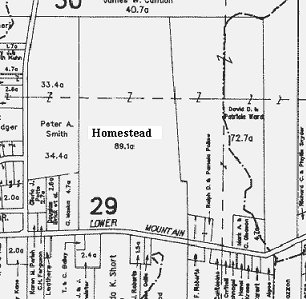 |
| Much of the original Howder Homestead, including the stone house, is within an 89.1 acre parcel in Lots 29/30, Range 7 of Cambria Township(9) |
George Howder passed away in 1856 and the history of the homestead became considerably more complicated over the next twenty years. George died intestate and his newly-widowed wife petitioned the Court for a settlement of estate(10). Son John left the adjacent frame house soon after George's death. He moved to Michigan where he married Electa Priest(11) in 1857. He fathered a boy he named George the following year,(12) perhaps in memory of his own father, and returned to Cambria by September 1859. No primary records have been found to show what happened to John's previous wife. The widow Mary, in the meantime married Ephraim Morrell, a ship carpenter, sometime before the end of 1859(13).
The unresolved nature of the estate continued to complicate ownership issues as a settlement wound its way through various legal processes. When the family mortgaged the property for $1,800 in 1859, all surviving heirs including Mary, her children, and all of their spouses had to agree to the mortgage and sign as witnesses(14). Mary soon thereafter petitioned the Court for a final settlement of estate(15). While a record of the Court's decision has not been located, it does appear that most of the heirs received a portion of the land as reflected by property transactions over the next couple of decades.
By the summer of 1860, the extended homestead family included Mary (Wescott, Howder) Morrell and her husband Ephraim, her daughters Laura (Howder) Campbell and Clarissa, and her sons John and Sylvester. Also included were Laura's daughter Mary Campbell, and John's wife Electa and son George. A seemingly unrelated person, Frederick Mawley a 17-year-old born in England, was also a resident and a laborer on the farm. Laura Howder kept house, and the sons John and Sylvester managed the farm. Sylvester was listed as "owner" (16) even though technically and legally he was likely just one of several family owners.
The Civil War transformed the Howder family as it did many other American households. John left the farm and enlisted twice in the United States Army, first with the 7th Cavalry Regiment, NY Volunteers and then with the 19 Independent Battery of Light Artillery, NY Volunteers. He participated in the Grand Review in Washington, DC when the war ended and mustered out on June 13, 1865. By October 10 he moved to Michigan and by all accounts he never returned to New York(17). He did not bring any family members with him, and in fact, no primary source material has ever been found to definitively determine the fate of his wife, Electa after 1860. Whether the war profoundly changed his personal outlook is unknown, but certainly it marked a dismissal of almost everything familiar to him. Three decades later while John was elderly and declining in health, he said that he hadn't communicated with his children in many years. He died destitute and alone in the Soldiers' Home, Kent County, Michigan in 1903(18). John's cousin William "Henry" Howder who resided in nearby Lockport was even less fortunate. Henry served in Co. C., 26th NY Infantry, and became part of the overwhelming Union casualties during the Battle of Fredericksburg, shot through the head in one of the repeated Federal attacks on the Confederate lines on December 13, 1862. His body was carried from the field and buried nearby(19).
Family membership at the homestead post-war looked much different from only five years earlier. Mary, the family matriarch, became a widow for a second time and reverted back to the Howder name. The daughters Laura (Howder) Campbell and Clarissa Howder still lived at home, as did granddaughter Mary Campbell. Mary Howder, Clarissa Howder, and Laura Campbell were all listed as co-owners. An unrelated family composed of the widow Mary Griffis and her eight children resided at the homestead, and the three older Griffis boys farmed the property. In the meantime Sylvester married Samaria D. Farnsworth, had three children, and moved with his family to Lockport Township where they had their own farm and a log home(20).
Stability gradually arrived in ensuing years as Sylvester renewed his interest in the homestead. He and Samaria systematically consolidated ownership through a series of land transactions with the remaining Howder heirs between 1867 and 1885, and incorporated various holdings belonging to his sisters, Laura (Howder) Campbell, Mary Ann (Howder) Farnsworth, and Clarissa (Howder) Levan(21).
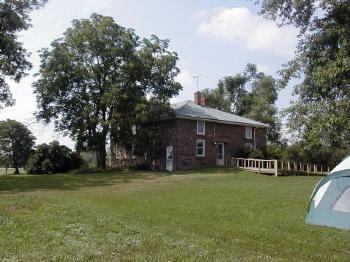 |
| Back (north) side of house, showing primarily the addition |
Sylvester and Samaria returned to the homestead as primary owners and occupiers by 1870 along with their five children: Albert, Mark, Effie, Lott and Mary. Sylvester's sister, Laura (Howder) Campbell continued to own one-third of the homestead and resided there with her daughter, Mary Campbell. This extended family was joined by John Howder's children: George, Lewis(22) and Adella. Sylvester and Laura raised John's children on the farm since John had left them behind when he moved to Michigan five years earlier(23). The widow Mary lived elsewhere at a location not yet known.
This extended family remained relatively stable over the next five years. Sylvester and Samaria (Farnsworth) Howder had one more child, a daughter they named Fanny. Mary Campbell married Frank Weaver and moved to a frame house a few properties east, later to be joined by her grandmother, the widow Mary. John's daughter Adella, who would have been about 12 years old, no longer appears in public records researched to date(24). Her whereabouts and ultimate fate are presently unknown although secondary sources imply that she passed away before adulthood.
The homestead family continued to change up through 1880. Sylvester and Samaria had two more children: Benjamin and Jacob Frank. The widow Mary, now 76 years old returned to the farm. All other extended family members departed. The nephew George, son of John, became a soldier stationed at Ft. Niagara. The nephew Lewis resided on the Royal Johnson farm in nearby Porter Township. Laura (Howder) Campbell swapped places with the widow Mary, moving in with Frank and Mary (Campbell) Weaver nearby(25).
The homestead continued to function under guidance from Sylvester Howder over subsequent years. Many of his children moved elsewhere as they matured. Burt, Ira and Mary remained on the farm. The matriarchal Widow Mary passed away suddenly in 1888 "at the home of her son, S. R. Howder"(26), surviving her husband George, who built the old stone house, by more than thirty years. As the 20th century approached the household dwindled to Sylvester, Samaria, and their adult children Burt, Mary and Ira(27). Sylvester struggled with declining mental health as he grew older(28) and Samaria passed away in 1904(29).
Burt Howder was listed as head of household the following year and he farmed the property along with his brother Ira. His sister Mary kept house(30). Sylvester continued to live on the homestead as did a young niece named E. Louis who has not been researched further. In 1907 Sylvester passed away, having resided on the farm for most of his life(31).
A period of great stability followed. Ironically the steadiness undermined and ultimately ended all Howder family ownership. Three Howder siblings, Burt, Ira and Mary, continued to work on the farm but none of them ever married. Burt continued as head of household up through 1910, with Ira assisting and Mary keeping house(32). By 1920, Ira became head of household, with Burt supporting and Mary continuing to keep house(33). The identical arrangement remained in place in 1930(34). Other Howders moved away from Niagara or pursued nonagricultural careers. Nobody returned to the farm and the three siblings continued to age. The homestead finally passed from family control after 110 years of continuous ownership after the siblings passed away.
Frank Howder's 1954 letter recounts the disposition of the Howder Homestead in the first half of the 20th Century:
"The farm was operated for years by the two bachelor sons of Sylvester R. Howder, namely Burt Howder and Ira F. Howder, with their spinster sister, Mary Ann Howder. Burt Howder died in 1932, and the farm was thereafter operated by Ira and his sister Mary, until the death of Ira F. Howder on January 6, 1945. Mary Ann Howder is also now deceased, but Ira F. Howder was the last one of this family to continue to work the farm until the time of his death. Thereafter the farm was split up, and the part with the house was sold to Mr. King a year or two after the death of Ira F. Howder"(35).
The House
The homestead is found on the north side of Lower Mountain Road. It can be clearly and easily recognized some distance away by the impressive stone house and the large red barn. The buildings sit near the southern edge of the property line. A driveway of perhaps 250 yards runs up to and past the immediate western side of the home. It then leads to a small parking area behind the house and continues further up to the front barn entrance, perhaps another hundred yards north.
The house is composed of the original ~1839 stone structure facing south towards Lower Mountain Road with an addition off the back that essentially doubles the footprint and square footage. Stonework on the original portion of the house is particularly well done and demonstrates a noticeably higher level of craftsmanship. Architectural details add an appealing sophistication to the design. A different type of stone serves as lintels above the front door and windows on the front side of the home. This is complemented by vertical accents along the front corners of the original house to create an appealing dovetail effect.
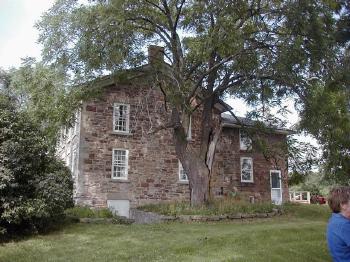 |
| East side, with original ~1839 home on left and addition on right |
The date of the addition is unknown but Frank Howder's letter implies that it most likely predates the 20th Century(36). Although it can't easily be seen in the photographs here, the stonework appears more haphazard and random than stonework found in the original building. It makes one wonder whether the addition was the work of a less gifted or less experienced mason or was a "do it yourself" project. Perhaps someone sacrificed quality for cost since it can not be seen easily from the road or from the front of the house. Nonetheless the addition continues to stand after more than a century so structural integrity is not in question. The difference then is aesthetic. Another key difference is that both the original structure and the addition provide two stories of living space but with different rooflines. The original roof slopes on two sides above the second floor, while the addition slopes on three sides back towards the original home.
The Barn
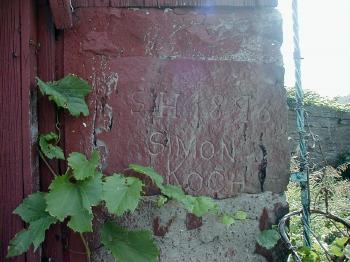 |
| Southwest cornerstone on barn dating to 1896, with intertwined grape leaves. The initials "S. H." likely refer to Sylvester Howder. |
A large red barn sits north of the house where the driveway terminates. An inscription on a southwestern cornerstone reads "S H 1896 / SIMON KOCH." An educated guess would be that the initials "S H" refer to Sylvester Howder who owned the homestead in 1896. No further information has been found on Simon Koch who may have been the builder or mason. The original barn caught fire somewhere around 1915 - 1918 according to the Frank Howder letter and the current structure was rebuilt on the surviving masonry foundation.
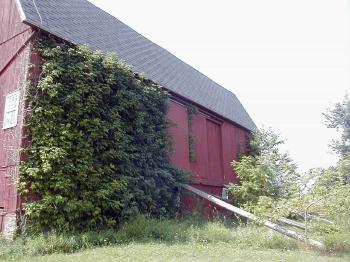 |
| Barn, back (north) side. Stabilizing poles are visible in the foreground, while others have fallen. Fruit trees are located in the underbrush to the right. |
The barn is divided into two portions by the stonework making up the foundation. The lower portion, enclosed by masonry walls several feet high and capped with a wooden ceiling, creates space for animal stalls and storage. A door at ground level on the eastern exterior wall provides access to this lower portion of the building. A much larger section above the stonework takes the form of a typical barn, enclosed entirely by an elaborate framework of wooden planking and beams. It creates one giant room from floorboard to rafter with large sliding doors in front (south) and back (north). The floor of the greater barn serves as a ceiling for the lower-level animal stall and storage area. Several feet of sloping earth provides access up from ground level to the front door, allowing tractors and other large machinery to enter the building.
The barn needed some fairly serious repairs during my visit in the summer of 2003. The current owners want to restore the barn to its original condition. The barn is a well-known landmark in the community due to its years of service, remarkable size and prominent visibility from Lower Mountain Road. These reasons, it was hoped, would increase the odds of procuring matching funds or grants to preserve the barn as a structure of historic significance. Previous owners attempted to stabilize the barn many years ago when they noticed it was sliding off the back of its foundation. They buttressed the barn by strategically placing utility poles, and some of those poles remain in place to prevent a possible collapse, while others have fallen. The barn stands now but it is hoped that repairs can be made before any decay becomes irreversible or it collapses.
The Grounds and Agriculture
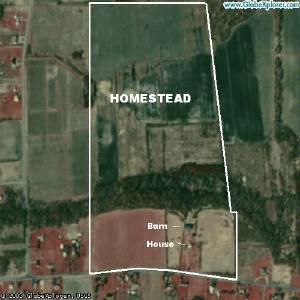 |
| The Homestead as it appeared in a satellite photo downloaded in 2003. Notice the overgrown horse paddock and riding track built in the 1950's to the right of the house and barn(37). |
The current property covers 89.1 acres, or about 60% of the original 1837 George Howder homestead. It stretches more than half a mile north-south and a quarter mile east-west. The house and barn sit uphill from Lower Mountain Road, approached by a gravel driveway about 250 yards long as measured somewhat imprecisely from satellite photographs and the Cambria Township map. The house sits close to the southern property boundary when viewed relative to the overall property footprint.
The Kings, who purchased the Homestead from the Howders, built a riding track and paddock for their horses in the field just to the east of the stone house. It is visible today but is a little overgrown and not much more than an empty, level field. Interestingly, the track shows up very clearly in satellite photographs.
There are reports of a small Howder Cemetery somewhere on the homestead(38). It is not known whether it would be on the current property or one of the several parcels sold separately over the years. The present owners were not aware of any possible locations, and indeed they had no knowledge of supposed gravesites at all. Well-known Howder plots are located in the Budd Cemetery elsewhere in Cambria and in the Glenwood cemetery in nearby Lockport. These memorialize several family members but also include some conspicuous inconsistencies that do not preclude the possibility of an additional cemetery located somewhere on the homestead(39). Perhaps people over time confused the family plot at Budd Cemetery with a separate Howder cemetery, perhaps not. But gravesites have yet to be found anywhere on the property.
The New York Agricultural Statistics of 1855 and 1865 provide a vivid portrayal of daily life on the homestead(40). The farm produced a divergent array of crops and livestock. Staples included large harvests of winter wheat, oats, corn and potatoes which were likely intended principally for resale. In addition, the family gathered fruit, baled hay, harvested beans, collected honey, raised beef cattle and swine, milked several cows and produced butter, raised chickens for meat and eggs, sheered and fleeced sheep, and owned several horses. With this level of activity and specialization the farm must have been a busy, hardworking operation.
The homestead orchard deserves further attention. It produced 30 bushels of apples and 3 barrels of cider in 1855, with the adjacent John Howder property producing another 375 bushels and 5 barrels. The homestead output increased to 150 bushels of apples and 4 bushels of pears in 1865. This volume is large enough to imply that much of it may have been for resale. Even so, I was quite surprised to find a number of fruit trees in the fields immediately adjacent to the west side of the house and barn and in underbrush by the northern edge of the barn. These trees were ancient, quite large, and well past their ability to produce fruit in commercial quantities. While it seems difficult to believe that any of these trees dated all the way back to the 1855-1865 agricultural surveys, they most likely would have been planted before the Howders sold the property in the 1940's, and likely would have been tended and nurtured by them.
I also noticed grape vines growing by the western side of the barn. Grape cultivation is common throughout the Niagara region but then again so are wild grapes. Since I haven't uncovered any cultivation records or evidence of a vineyard to prove otherwise, I believe they were probably wild.
The property includes a flooded and abandoned quarry. According to the current occupants, stone extracted from the pit served as building material for homes as far away as Buffalo. I was not able to see the quarry because of thick vegetation blocking any possible access. It is difficult to reach the quarry except in wintertime. Even a satellite photo of the property does not clearly show where the quarry might be, probably because of the overgrowth. It might be found somewhere in the wide green belt running through the bottom third of the photograph. Interestingly, the vegetation belt continues onto adjacent properties. Could this be a creek or ravine? The satellite photograph also shows that the northern two-thirds of the homestead appears to be cultivated in patterns similar to adjacent properties. Because none of the post-Howder owners were farmers by trade, one might assume that the fields may have been rented out to nearby local farmers. It also appears that what is being grown in the back portion of the property is different from that in the front portion at least at the time the photo was taken.
Summary
The Howder homestead spanned a 110 year period from roughly 1837 to 1947, overlapping Western New York history from its early settlement and near wilderness up to the modern age. Three generations of Howders and their extended families relied on their Cambria Township farm as a stabilizing influence while the nation around them grew. People slowly spun from the homestead as society provided new opportunities and occupational choices. Eventually the farm ceased to provide any practical purpose for a family that no longer depended on agriculture. Without an anchor, the family quickly left Niagara and spread throughout the United States.
Early Descendants of Christian and Mary (Houstater) Howder, original settlers in Niagara County, via their son George
(Family Members who lived on the Howder Homestead are hyperlinked to their genealogy file)
1 Christian Howder (1770 - 1831)
.. +Mary Houstater (1780 - 1835)
......... 2 George Howder (1801 - 1856)
............. +Mary Wescott (1804 - 1888)
.................... 3 Laura G. Howder (1824 -)
........................+Benjamin Campbell (Unknown - 1855)
............................... 4 Mary L. Campbell (1851 - 1881)
...................................+Frank A. Weaver (1852 -)
.................... 3 John M. Howder (1828 - 1903)
........................+Mary ? (1833 - Unknown)
.................... *2nd Wife of John M. Howder:
........................+Electa J. Priest (1830 - Unknown)
............................... 4 George Roderick Howder (1858 - 1926)
................................... +Mary Lucinda Chapman (1851 - 1932)
............................... 4 Lewis Henry Howder (1860 - 1928)
...................................+Jane Frances Hayes (1858 - 1929)
............................... 4 Adella H. Howder (1863 - 1872)
.................... 3 Mary Ann Howder (1831 - Unknown)
........................+Solomon C. Farnsworth (Unknown - 1880)
.................... 3 Sylvester R. Howder (1832 - 1907)
........................+Samaria D. Farnsworth (1837 - 1904)
............................... 4 Albert S. Howder (1860 - 1934)
............................... 4 Mark Howder (1862 - 1938)
...................................+Elwina Miller (1877 - 1961)
............................... 4 Effie Loesa Howder (1863 - 1904)
...................................+Ernest Elmer Sabin (1861 - 1903)
............................... 4 Lott M. Howder (1868 - 1954)
........................................... 5 Frank J. Howder (1905 - 1985)
............................... 4 Mary Ann Howder (1871 - 1949)
............................... 4 Fannie L. Howder (1871 - 1911)
............................... 4 Benjamin Franklin Howder (1874 - 1958)
...................................+Mary L. Pierce (1861 - 1935)
............................... 4 Ira Farnsworth Howder (1879 - 1945)
.................... 3 Clarisa D. Howder (1846 - Unknown)
........................+Lewis Levan (Unknown - Unknown)
If You are Related to this Lineage...
If you descend from the Howder family of Niagara Co., NY, please contact me. I have more information to share. In return, I would like to get copies of any primary sources you have researched and include your family information in my database. You can reach me by e-mail.
Endnotes
(1) This public version differs from the complete version in several respects, mainly to protect the privacy of the current occupants. References to the street address, names of the current occupants, and descriptions of the interior of the home are not included. The complete version is available from the author based on a bonafide need or interest from a member of the Howder family or from the family of the current occupants.
(2) In support of 1811: The Niagara County Genealogical Society library in its Howder biography file contains a reference to John Howder, son of Christian, arriving in Niagara in 1811, citing the "Notes of Josh Wilbur" Volume III, page 362. In support of 1812: A letter from Frank J. Howder, Esq., to Clarence O. Lewis, Niagara County Historian, March 12, 1954, states that Christian (listed as Christopher) Howder arrived in Cambria in 1812. In support of 1814: The Niagara County Grantee Index 1800-1891 includes the earliest primary record yet uncovered. It details a land purchase made by Christian Howder from W. Willink & Co (Wilhelm Willink was an original member of the Holland Land Purchase association) dated 1814 and recorded twenty-one years later in 1835 for 148 acres in Township 17 (Cambria), Range 7 (eastern half), Lot 37.
(3) Niagara County Grantee Index, 1800-1891. The George Howder purchase that became the Old Howder Homestead was located in Township 14 (Cambria), Range 7 (eastern half), straddling lots 29 and 30. This property was a few lots east of the Christian Howder property. John Howder, George's brother, had holdings just to the north in Lot 31. Distance measurements are based upon "chains" and "links," which could conceivably be converted to modern measurements should one be inclined to undertake this task.
(4) Letter from Frank J. Howder, Esq., to Clarence O. Lewis, Niagara County Historian, March 12, 1954. Mr. Howder provided an outline of the history of the homestead based upon personal recollection and unspecified family sources.
(5) Town of Cambria, New York website, August 22, 2003, http://www.townofcambria.com/historian.htm, "About 1799, lands in this territory of Western New York were opened for sale. A group of Amsterdam citizens purchased three and one-half million acres of it, and the area came to be known as the Holland Land Purchase." Many of the deeds, mortgages, probate records, etc., I have uncovered also refer to the area this way either directly or indirectly.
(6) Undated letter from Clarence O. Lewis, Niagara County Historian, to Mrs. William Peters, possibly late 1960's. Mrs. Peters was attempting to ascertain the construction date of the old stone house. Mr. Lewis provided a range of years, and suggested that Mrs. Peters could review the Abstract of Title for "a decided increase in value or a sizable mortgage" for further clues.
(7) 1850 United States Census, New York, Niagara Co., Cambria Twp.: Page 558; August 26, 1850.
(8) 1855 New York State Census, Niagara Co., Cambria Twp.: June 11, 1855. The George Howder family is listed at dwelling 116, family 125, and the John Howder family is listed at dwelling 117, family 126. See also accompanying New York State Census Agricultural Statistics.
(9) Town of Cambria, New York website, August 22, 2003, http://www.townofcambria.com/town_map.htm source map, annotated.
(10) "In the Surrogate of the County of Niagara (NY), petition of Mary Howder for the settlement of the estate of George Howder, who died on the Nineteenth of November 1856 without a will." December 1, 1856.
(11) John M. Howden [sic.] married Electa J. Preast [sic.] on June 22, 1857. Latter Day Saints; International Genealogical Index v5.0, Batch M518462, Source Call No. 0960508 (Record of marriages 1837-1903; index to marriages 1837-1974 Ionia County (Michigan). County Clerk). The two minor spelling errors in the surnames would be more disconcerting if it weren't already well-established that (a) the Howder surname is frequently misspelled in a number of interesting ways with "Howden" being particularly common; (b) the Priest family were longtime residents of Ionia Co., MI, and misspellings of this nature all trace back to known family members; and (c) other documentation circa 1859-1860 detailed elsewhere herein link John M. and Electa J. (Priest) Howder as husband and wife.
(12) Various census records point to George Roderick Howder being born in Michigan in 1858. His United States Army discharge certificate, October 15, 1884, defines his birthplace specifically as Lansing, Michigan. When George's daughter Rosa Nell (Howder) Turner compiled her record of family information from memory, she listed his birthday as April 12, 1858.
(13) "Indenture between Ephraim Morrell & Mary Morrell, the said Mary being formerly Mary Howder widow, & Sylvester R. Howder & Samaria his wife, Laura G. Campbell, John M. Howder & Electa his wife & Clarissa D. Howder of the Town of Cambria & Solomon G. Farnsworth & Mary his wife of Lockport in the County of Niagara, State of New York & children & heirs at large of George Howder late of said County deceased, parties of the first part & Frederic Bronson Esquire of the City, County & State of New York party of the second part." September 1, 1859.
(14) "Indenture between Ephraim Morrell & Mary Morrell...". September 1, 1859
(15) "Petition for Final Settlement to the Surrogate of the County of Niagara (NY), for the estate of George Howder." January 23, 1860.
(16) 1860 United States Census, New York, Niagara Co., Cambria Twp.: Pages 49-50; July 19, 1860.
(17) Pension file for John Howder, National Archives and Records Administration, Washington DC. Invalid application 1,146,483 filed in Michigan, February 20, 1893; Certificate 929,804.
(18) John M. Howder is buried at the Grand Rapids Home for Veterans, Kent Co., Michigan, plot 4, row 14, grave 15.
(19) Pension file for William Henry Howder, National Archives and Records Administration, Washington DC. Mother's application 150,197 filed in New York, July 22, 1867; Certificate 112,630.
(20) 1865 New York State Census, Niagara Co., Cambria Twp: dwelling 184 (Mary Howder family) and Lockport Twp.: 4th District, dwelling 47 (Sylvester Howder family), June 20, 1865. See also accompanying New York State Census Agricultural Statistics.
(21) Niagara County Grantee Index, 1800-1891. Numerous parcels in Township 14, Range 7, Lot 29/30 changed hands from original inheritors of the George Howder estate to grantees Sylvester R. or Samaria D. Howder from 1867-1869 and 1882-1885. Reasons for the transactions probably varied. Mary (Howder) Farnsworth was living in nearby Lockport when she sold her holdings in 1867. Clarissa D. (Howder) Levan married Lewis Levan on August 2, 1865, according to the Ionia Co., MI Marriage Index and was presumably residing in Michigan when she sold two of her holdings in 1869. Laura (Howder) Campbell was still living on the homestead and retained ownership of her holdings until 1882 and 1885.
(22) Lewis Howder is the author's great-grandfather.
(23) 1870 United States Census, New York, Niagara Co., Cambria Twp.: Page 35; June 30, 1870..
(24) 1875 New York State Census, Niagara Co., Cambria Twp.: District 1; June 1-2, 1875. The Howders are listed under dwelling 8 and the Weavers under dwelling 11.
(25) 1880 United States Census, New York, Niagara Co., (a) Cambria Twp. - Sylvester Howder family (Howder Homestead), Enumeration District 176, Page 42, June 25-26, 1880; (b) the Weavers under Cambria, Niagara Co., NY; and (c) George & Lewis Howder under Porter, Niagara Co., NY.
(26) Lockport [NY] Daily Journal, February 1, 1888, page 3, column 4.
(27) 1900 United States Census, New York, Niagara Co., Cambria Twp: Enumeration District 46; Page 8; June 19, 1910.
(28) Newspaper clipping in the Howder biography file, Niagara County Genealogical Society. May 1900: "Was Hardly Insane. Sylvester R. Howder of the town of Cambria was released from the county jail about 5 o'clock yesterday afternoon. The medical examination proved that the old man was not insane, but possibly weak minded. Accordingly he could not be committed to an asylum."
(29) Lockport [NY] Daily Journal, September 8, 1904, page 6, column 5.
(30) 1905 New York State Census, Niagara Co., Cambria Twp.: District 1, June 1, 1905.
(31) Sylvester Howder's tombstone at the Budd Cemetery, on Budd Road, Cambria, Niagara Co., NY. Several other Sylvester Howder family members are also buried at the Budd Cemetery, which is located maybe a mile or so from the Howder Homestead.
(32) 1910 United States Census, New York, Niagara Co., Cambria Twp: Enumeration District 69; Page 1; April 15-16, 1910.
(33) 1920 United States Census, New York, Niagara Co., Cambria Twp: Enumeration District 69; Page 5A; January 9-10, 1920.
(34) 1930 United States Census, New York, Niagara Co., Cambria Twp: Enumeration District 32-1; Page 8B; April 19, 1930.
(35) Letter from Frank J. Howder.
(36) Letter from Frank J. Howder. In his lifetime "the old stone house has remained the same, except that the recent purchaser in about 1947Ö has remodeled it to some extent."
(37) This photograph was downloaded from Mapquest although it lists GlobeXplorer.com as its primary source.
(38) On such reference is at Niagara County Cemeteries which says, "This is a small cemetery located on the George Howder farmÖ No stones found recently."
(39) Looking simply at the tombstones provides an indication, but not confirmation of interment; I have not had an opportunity to examine interment records. Budd Cemetery has markers for: Sylvester R. Howder and his wife Samaria D. Farnsworth [Howder]; Ira F. Howder; Mary A. Howder; Fannie L. Howder Lewis; Burt S. Howder; Mark Howder; Elwina [Miller] Howder; and Emma J. Glenwood Cemetery section 14, plot 39, has markers for: Christian Howder; Mary Haustater [Howder], E. E. [Ernest Elmer] Sabin and his wife E. L. [Effie Loesa] Howder [Sabin]; George Howder and his wife Mary Wescott [Howder]; S.R [Sylvester R.] Howder and his wife S. D. [Samaria D.] Farnsworth [Howder]; James Howder; Laura G. [Howder] Campbell; and Mary [Campbell] Weaver. Nearby in the same section, plot 31, includes members of the Lockport branch of the Howder family: John Howder [brother of George Howder who owned the homestead] and his wife Electa A. [Warren] -- not to be confused with George's son John and wife Electa -- and sons Truman A. Howder and William Henry Howder. It is abundantly obvious that some of the markers are memorial stones rather than tombstones, or were inscribed in anticipation of serving as a final resting place but the person may have elected to be interred elsewhere: Sylvester and Samaria can't be buried in both cemeteries at the same time; several of the Howders in Glenwood passed away before the Glenwood Cemetery Association was founded in 1863; Civil War pension records indicate William Henry Howder was buried in Fredericksburg after the battle; and Laura Campbell's marker has a date of birth but the date of passing has been left blank.
(40) 1855 New York State Census Agricultural Statistics, Niagara Co., Cambria Twp.: June 11, 1855, and 1865 New York State Census Agricultural Statistics, Niagara Co., Cambria Twp.: June 20, 1865.